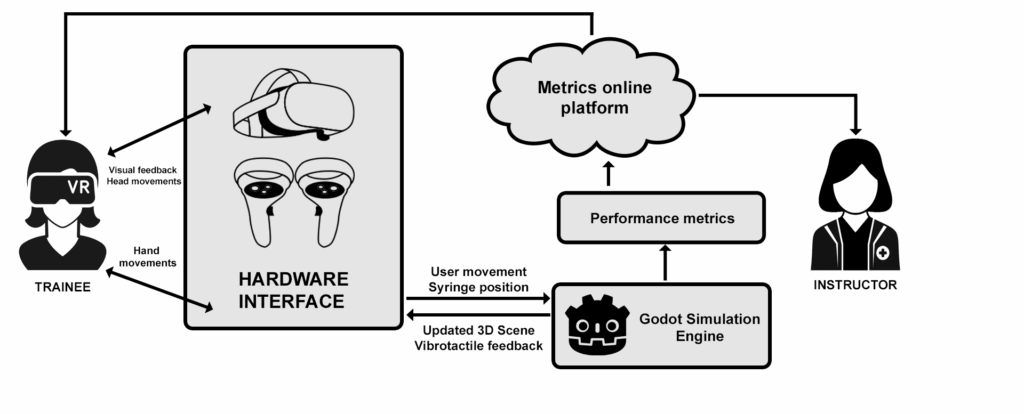Training the Next Generation of Dental Practitioners with Virtual Reality

Nerve block injections are one of the most technique-sensitive procedures in operational dentistry. Current learning paradigms involve practicing on classmates or mannequins, which is risky and/or expensive. Thanks to advances in simulation technology, it is now possible to learn through an immersive, realistic, and risk-free virtual environment.
At the intersection of dentistry, education, and cutting-edge virtual reality (VR), Kitware and the University of North Carolina at Chapel Hill’s Adams School of Dentistry have developed AnesthesiaSim, a high-fidelity, interactive VR simulator designed to train clinicians in administering mandibular nerve blocks. Whether you are a dental hygiene student, emergency physician, or nurse anesthetist, this tool can help you gain confidence and skill without needing to inject anyone or anything first.
Why Simulation Will Play a Major Role in the Future of Dental Anesthesia
Traditional dental anesthesia training usually involves three phases:
- Injecting oranges for haptic feedback learning.
- Practicing on mannequins for anatomical learning.
- Injecting classmates.
While effective to a degree, these methods are limited in realism, can be too costly, or are not without ethical complexities. For example, injecting another student with anesthetic when there is no therapeutic purpose can raise concerns. Additionally, mannequins wear out, are expensive to replace, and offer limited feedback.

Simulation offers a solution. VR systems can provide standardized, repeatable, and safe practice scenarios. They are scalable, cost-effective, and adaptable to individual learners. Most importantly, they can offer real-time feedback and performance metrics that help both students and instructors track progress.
Enter AnesthesiaSim: What It Does
AnesthesiaSim is a virtual reality training system built in Godot v4.1.3 and using the Meta Oculus Quest 2. Godot is a free and open source game engine that supports the development of medical visualization and VR applications through its OpenXR plugin and built-in Python-inspired scripting language called GDScript. The engine’s built-in physics capabilities allow us to detect collisions between objects and design events and user interactions for our simulation scenarios.

The simulation scenario includes a surgical room with a high fidelity representation of the patient’s skeleton and facial and buccal soft tissues presented in supine position. Our subject matter experts recommended this position over a seated one because they have found that patients receiving mandibular blocks are more stable lying down. In this scenario, the students can administer simulated local anesthetic injections for mandibular nerve blocks that target the Inferior Alveolar and Lingual nerves.

The simulator also incorporates:
- Immersive visuals rendered from real patient anatomy coming from CBCT scans.
- Vibrotactile feedback when the virtual needle penetrates gum or touches bone.
- Performance metrics, including distance from optimal targets and needle trajectory.
- Adjustable learning modes, from transparent anatomical overlays to blind injections.
Within the surgical scenario, students start by orienting themselves in a virtual operating room, adjusting the patient and equipment just as they would in real life. The simulator allows for them to perform the injection by navigating through the gum tissue, targeting the condylar bone, and depositing the anesthetic—all while receiving real-time feedback.
What Makes AnesthesiaSim Unique
Many simulators offer some version of realism, but AnesthesiaSim goes further:
- Based on real anatomy: All anatomical models are generated from de-identified patient scans, ensuring clinical accuracy.
- Quantitative performance feedback: All training results are collected in a private, access-controlled cloud service. This aids in cultivating business intelligence around product efficacy, as well as providing the ability for individual trainees and their instructors to track their scores longitudinally.
- Cloud-based training sessions: Instructors can manage sessions remotely, track performance, and onboard students without needing them to register individually.

Our simulator has been tested across three institutions over a 6-month pilot: Central Carolina Community College, Wake Tech, and UNC Adams School of Dentistry. All students reported more confidence, and the instructors appreciated the standardization and ability to track injection accuracy metrics over time. And everyone agreed: technologies such as this one are a leap forward in dental anesthesia education.
What’s Next?
As we continue gathering results, we plan to continue iterating on design, as well as expanding access to other institutions and generalizing the simulator with more injection types. Challenges such as ensuring consistent hardware availability, refining feedback mechanisms, and adapting for broader procedures remain, but the path is clear. Virtual simulation in dental training is not a novelty anymore. It is a necessity. With the rise of artificial intelligence and the current surge of digital medicine, VR simulators like AnesthesiaSim offer a glimpse into the future of hands-on learning: safer, smarter, and more effective. We are not just building tools, we are redefining how clinicians learn.
We can help you bring your medical training vision to life!
AnesthesiaSim shows what’s possible when cutting-edge visualization meets real clinical challenges. If you’re exploring VR or simulation-based training, Kitware can partner with you to create a powerful, customized solution. Reach out to our domain experts to explore the possibilities.
Acknowledgements
AnesthesiaSim is made possible through contributions from a multidisciplinary team coming from Kitware and The University of North Carolina at Chapel Hill Adams School of Dentistry. The development of AnesthesiaSim has been also partially supported by the NIH National Institute of Dental and Craniofacial Research R44DE027595 (High-fidelity Virtual Reality Trainer for Orthognathic Surgery).
Research reported in this publication was supported by the National Institute Of Dental & Craniofacial Research of the National Institutes of Health under Award Numbers R44DE027574 and R44DE27595. The content is solely the responsibility of the authors and does not necessarily represent the official views of the National Institutes of Health.